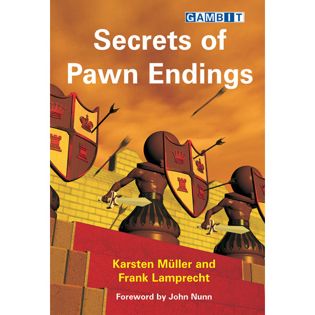Secrets of Pawn Endings
Karsten Muller, Mark Lamprecht

For those chess players who partake in a long walk spoiled golf the following analogy may ring true: driving(golf)/openings(chess) are for show, but putting (golf)/endings(chess) are for dough.
Talk to club and tournament circuit players who hold a decent amount of endgame theory under their belt, and they can effortlessly recount tales of memorable draws and wins stolen from inferior or lost(!) positions. Was it worth the extra study of endgame theory? If you were ever on the receiving versus giving end of an endgame smack down, you might grudgingly mutter, Yes.
Players skill sets develop for different reasons and at varying rates, and for those whose chess maturity levels are ready for the rewards, which never quit giving, of some serious studying of pawn endgames, I warmly recommend Secrets of Pawn Endings by Karsten Muller and Frank Lamprecht.
The authors, utilizing years of coaching and teaching chess have distilled the most important, practical, and instructive examples in pawn endings without allowing the readers to be shortchanged by insufficient samples or sidelined by subtle superflurosity.
Following the concise and informative forward by Dr. Nunn, the grateful preface by authors, a suggested crash course is provided for impatient readers with time constraints, and a brief explanation of the Nunn Convention which provides a logical and objective application of the evaluation symbols !, ?, ?!, and ?.
Comparing endgame books, one can easily conclude there are several logical methods in which to organize material. I find the path chosen for this book to be a gentle sloping path of increasing logical complexity while avoiding misplacing concepts and ideas.
Here is a rundown on the chapters:
1) K&P vs. K
2) K&P vs. K&P
3) Race of Passed Pawns
4) Small Number of Pawns 2 vs. 1
5) Unique Features of Rooks Pawns
6) Fortress, Stalemates, and Underpromotion
7) Pawns on One Wing
8) Passed Pawns
9) Breakthrough
10) Pawns on both wings
11) Fight for Tempi and Maneuvers
12) Corresponding Squares (this chapter kicks my cerebrum)
13) Thinking Methods to Find the Right Moves
14) Complicated Cases
15) Simplification
16) Exercises (sorted as easy, difficult, and judge the position)
Each chapter concludes with a series of problems rated from one to five stars in difficulty. Serious attempts in seeking the solution will greatly augment study of the chapters content.
Examples include many real-life snapshots from contemporary play mixed in with a few classics from the day of Rubinstein, Chigorin, Nimzowitsch, and Tarrasch, as well as carefully selected compositions headed by the pawn endgame god, Nickolai Grigoiev. Each position has been checked with Hiracs 7.3.2, the omniscient Nalimov tablebases and the extraordinary Lars Rasmussen program which digests pawn endgames. While the authors are not the first to utilize the aforementioned Nunn convention, they are the first to do so beyond the safety net of five-piece tablebases.
Consider, for comparison purposes, the books chapter covering pawn vs. pawn with other endgame texts. The time-honored Averbakh volume (Pawn Endings) contains over six dozen of this sub-branch, but this presents to the reader, not a meal, but a feast of gluttony, easily overwhelming the palate of most endgame students. Other writers, Grivas (Mastering the Basics), and Snape (Chess Endings Made Simple), offer a handful of crumbs. Silman (Complete Endgame Course) and Dvoretsky (Endgame Manual) provide a few hors d’oeuvres, but hardly sufficient calories. To be fair, most of the works cited for comparison, excellent in their own right, provide a one-size-fits-all comprehensive endgame works, and justly serve their purpose. But Muller & Lamprecht, afforded the luxury of focusing on the single endgame branch of pawn endings provide the recommended daily allowance of fourteen critical dueling pawns endgames.
Opening theory certainly has its place and value for ones chess improvement, but for those who can turn from the dark side if superficial gains in chess study, Secrets of Pawn Endings provides a path for continual return on investment of time and effort.
